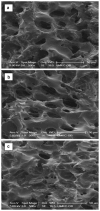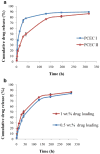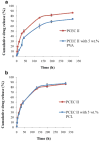Effect of hydrophobic and hydrophilic additives on sol-gel transition and release behavior of timolol maleate from polycaprolactone-based hydrogel
- PMID: 21892247
- PMCID: PMC3164763
- DOI: 10.1007/s00396-011-2476-y
Effect of hydrophobic and hydrophilic additives on sol-gel transition and release behavior of timolol maleate from polycaprolactone-based hydrogel
Abstract
The objective of this work was to delineate the effect of hydrophilic and hydrophobic polymeric additives on sol-gel transition and release profile of timolol maleate (TM) from poly (ethylene glycol)-poly (ε-caprolactone)- poly (ethylene glycol) (PEG-PCL-PEG)-based thermosensitive hydrogel. Polycaprolactone (hydrophobic additive) and polyvinyl alcohol (PVA) (hydrophilic additive) reduced critical gel concentration of PEG-PCL-PEG triblock polymer. The effect of PCL on sol-gel transition was more pronounced than PVA. However, with PCL no statistically significant difference in release profile was observed. The effect of PVA on release profile was more pronounced, which reduced the cumulative percentage release of TM from 86.4±0.8% to 73.7±1.8% over 316 h. Moreover, cytotoxicity of the hydrogel was also investigated utilizing rabbit primary corneal epithelial culture cells. No significant cytotoxicity of hydrogel alone or in presence of additives was observed. So, polymeric additive strategy serves as a valuable tool for optimizing TM release kinetics from PEG-PCL-PEG hydrogel matrix.
Figures








 and PCEC II
and PCEC II
 triblock copolymer (25 wt. %) hydrogel; b release of TM
triblock copolymer (25 wt. %) hydrogel; b release of TM
 0.5 and
0.5 and
 1.0 wt.% from PCEC II triblock copolymer (25 wt.%) hydrogel in PBS buffer (pH 7.4) at 37 °C. The values are represented as mean ± standard deviation of n=3
1.0 wt.% from PCEC II triblock copolymer (25 wt.%) hydrogel in PBS buffer (pH 7.4) at 37 °C. The values are represented as mean ± standard deviation of n=3
 and PCEC II (20 wt.%) with 5 wt.% PVA
and PCEC II (20 wt.%) with 5 wt.% PVA
 ; b release of TM from PCEC II (25 wt.%)
; b release of TM from PCEC II (25 wt.%)
 and PCEC II (20 wt.%) with 5 wt.% PCL
and PCEC II (20 wt.%) with 5 wt.% PCL
 hydrogel in PBS buffer (pH 7.4) at 37 °C. The values are represented as mean ± standard deviation of n=3
hydrogel in PBS buffer (pH 7.4) at 37 °C. The values are represented as mean ± standard deviation of n=3
Similar articles
-
In vitro drug release behavior from a novel thermosensitive composite hydrogel based on Pluronic f127 and poly(ethylene glycol)-poly(epsilon-caprolactone)-poly(ethylene glycol) copolymer.BMC Biotechnol. 2009 Feb 11;9:8. doi: 10.1186/1472-6750-9-8. BMC Biotechnol. 2009. PMID: 19210779 Free PMC article.
-
Novel composite drug delivery system for honokiol delivery: self-assembled poly(ethylene glycol)-poly(epsilon-caprolactone)-poly(ethylene glycol) micelles in thermosensitive poly(ethylene glycol)-poly(epsilon-caprolactone)-poly(ethylene glycol) hydrogel.J Phys Chem B. 2009 Jul 30;113(30):10183-8. doi: 10.1021/jp902697d. J Phys Chem B. 2009. PMID: 19572675
-
Polymeric matrix for drug delivery: honokiol-loaded PCL-PEG-PCL nanoparticles in PEG-PCL-PEG thermosensitive hydrogel.J Biomed Mater Res A. 2010 Apr;93(1):219-26. doi: 10.1002/jbm.a.32546. J Biomed Mater Res A. 2010. PMID: 19557789
-
Small interfering RNA for cancer treatment: overcoming hurdles in delivery.Acta Pharm Sin B. 2020 Nov;10(11):2075-2109. doi: 10.1016/j.apsb.2020.10.005. Epub 2020 Oct 13. Acta Pharm Sin B. 2020. PMID: 33304780 Free PMC article. Review.
-
Injectable thermosensitive hydrogel systems based on functional PEG/PCL block polymer for local drug delivery.J Control Release. 2019 Mar 10;297:60-70. doi: 10.1016/j.jconrel.2019.01.026. Epub 2019 Jan 23. J Control Release. 2019. PMID: 30684513 Review.
Cited by
-
Fabrication and examination of polyorganophosphazene/polycaprolactone-based scaffold with degradation, in vitro and in vivo behaviors suitable for tissue engineering applications.Sci Rep. 2022 Nov 1;12(1):18407. doi: 10.1038/s41598-022-18632-8. Sci Rep. 2022. PMID: 36319793 Free PMC article.
-
Synthesis and Characterization of Ciprofloxacin Loaded Star-Shaped Polycaprolactone-Polyethylene Glycol Hydrogels for Oral Delivery.Micromachines (Basel). 2023 Jul 6;14(7):1382. doi: 10.3390/mi14071382. Micromachines (Basel). 2023. PMID: 37512693 Free PMC article.
-
A biodegradable ocular implant for long-term suppression of intraocular pressure.Drug Deliv Transl Res. 2015 Oct;5(5):469-79. doi: 10.1007/s13346-015-0240-4. Drug Deliv Transl Res. 2015. PMID: 26100093 Free PMC article.
-
Novel Pentablock Copolymers as Thermosensitive Self-Assembling Micelles for Ocular Drug Delivery.Adv Pharm Bull. 2017 Apr;7(1):11-20. doi: 10.15171/apb.2017.003. Epub 2017 Apr 13. Adv Pharm Bull. 2017. PMID: 28507933 Free PMC article. Review.
-
Reversible hydrophobic ion-paring complex strategy to minimize acylation of octreotide during long-term delivery from PLGA microparticles.Int J Pharm. 2015 Jul 15;489(1-2):237-45. doi: 10.1016/j.ijpharm.2015.04.075. Epub 2015 May 1. Int J Pharm. 2015. PMID: 25940041 Free PMC article.
References
Grants and funding
LinkOut - more resources
Full Text Sources
Miscellaneous
